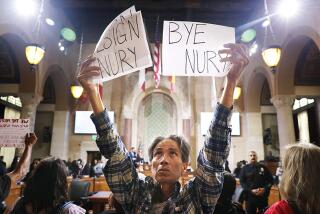Stock Trading Data Indicate Business Week Leaks for More Than 2 Years
- Share via
NEW YORK — Records of stock trading suggest that pre-publication leaks of what would appear in Business Week magazine’s “Inside Wall Street” column may have gone on for more than two years, substantially longer than previously suspected.
As reported, the business magazine, a unit of McGraw-Hill Inc., disclosed Thursday that it was conducting an internal investigation into possible leaks of which stocks the widely read column was about to recommend. The leaks apparently were the cause of sharp price and volume increases of the stocks on Thursdays, the day before the magazine became available to the public. A Business Week spokeswoman had said the investigation was focusing on unusual trading during the past two months.
However, a comparison by The Times of stock records on the Thursday before the magazine came out show apparent instances of unusual trading as early as January, 1986. In a telephone interview Monday, Stephen B. Shepard, editor-in-chief of Business Week, refused to say if the investigation had been broadened to look at possible leaks earlier than two months ago.
“I’m not commenting about anything about the timing,” Shepard said, adding that “we’re not ruling out anything. Obviously, we’re tracking it over a period of time.”
Shepard refused to comment when asked about specific dates and examples. He also refused to comment on a report contained in the forthcoming issue of TJFR, a journalism newsletter, which cites unnamed Business Week staffers as saying that the magazine’s editors were aware of unusual trading as early as March, 1987. The TJFR report said Business Week’s editors took steps to limit the number of employees who had access to advance copies of the magazine.
Shepard said the column’s author, Gene G. Marcial, was the one who first brought the problem to the editors’ attention and said he isn’t under suspicion for any wrongdoing.
Among examples of earlier suspicious trading found by comparing stocks recommended in the column with closing quotes on the Thursday before the Business Week issue appeared were:
- Trading in Carson Pirie Scott & Co. in March, 1988. In the issue that came out on March 25, the “Inside Wall Street” column referred to the company’s stock as “a bargain.” On Thursday, March 24, the day the magazine was printed but not yet released to the public, the company’s stock closed at $13.25 a share on the New York Stock Exchange, up from $11.75 the day before. Trading volume of the stock on Thursday rose dramatically to 5.7 million shares, compared to 625,000 the day before. The market as a whole was down that day, with the Dow Jones industrial index closing 44 points lower.
In response to queries from the NYSE, the company issued an announcement March 24 saying it didn’t know of any reason for the stock’s surge.
- A price rise of Custom Energy Services Inc. stock on the day before the magazine touted the company’s “near-miraculous turnabout.”
On Thursday, Jan. 8, 1987, the day before the issue came out, Custom Energy’s stock closed at $1.375 a share on the American Stock Exchange, up from 87.5 cents the preceding day.
Volume totaled nearly three times what it had been earlier in the week. However, the market as a whole was up slightly that day, with the Dow industrials gaining 8.3 points.
- Trading in the stock of Maxaxam Corp. in January, 1986. On Thursday, Jan. 30, 1986, the day before copies of the magazine were distributed with a favorable report on Maxaxam, the stock jumped to $5.031 per share in over-the-counter trading, up from $4.719 on volume of 226,200 shares, nearly three times the volume of the preceding days.
The Dow index closed 6.76 points lower that day.
A spokeswoman for Business Week confirmed that memos were distributed Monday to all of the magazine’s reporters and editors, advising them not to answer other journalists’ questions about the inquiry while the magazine’s internal investigation is under way.
The Securities and Exchange Commission has declined to say whether it is considering opening its own investigation.
More to Read
Inside the business of entertainment
The Wide Shot brings you news, analysis and insights on everything from streaming wars to production — and what it all means for the future.
You may occasionally receive promotional content from the Los Angeles Times.








